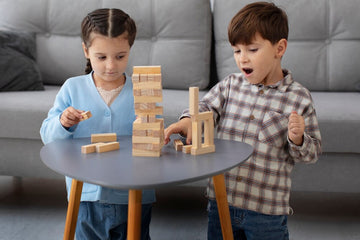Wooden Toy Safety Tips: A Guide for Parents and Caregivers

Wooden toys have been cherished by generations for their timeless charm and educational benefits. They captivate young minds with their simplicity, encourage imaginative play, and promote child development. However, like any other toys, it's important to ensure that wooden toys are used safely to prevent accidents and promote a secure play environment for children. In this blog, we'll provide essential safety tips for parents and caregivers when selecting and using wooden toys for young children.
- Age-Appropriate Selection: When choosing wooden toys for your child, pay close attention to age recommendations provided by the manufacturer. These guidelines are based on the toy's complexity, small parts, and potential choking hazards. Select toys that match your child's developmental stage to ensure safe and age-appropriate play.
- Check for Small Parts: Inspect the wooden toy carefully to identify any small parts that might come loose or break off. Ensure that these parts are securely attached and cannot be easily dislodged, especially for children under 3 years old who tend to put objects in their mouths.
- Non-Toxic Materials: Look for wooden toys that are made from non-toxic and child-safe materials. Most reputable manufacturers use water-based paints and finishes that are free from harmful chemicals. Avoid toys with strong chemical odors or peeling paint.
- Smooth Surfaces: Run your hands over the wooden toy's surfaces to check for any rough edges or splinters. Wooden toys should have smooth, sanded edges to prevent cuts or splinters during play.
- Sturdy Construction: Inspect the toy for durability. Ensure that it's well-constructed and won't easily break apart, which can create sharp edges or expose small parts. Wooden toys are known for their durability, but it's always wise to double-check.
- Avoid Strings and Cords: Be cautious with wooden toys that have strings, cords, or ropes. These can pose a strangulation risk, especially if they're long and easily tangled. Make sure they are short and securely attached to the toy.
- Supervision is Key: No matter how safe a toy may be, supervision is crucial, especially for younger children. Always keep an eye on your child during playtime to prevent accidents and address any potential hazards promptly.
- Regular Inspections: Regularly inspect wooden toys for wear and tear. Check for loose parts, cracks, or any damage that may compromise safety. Discard or repair damaged toys promptly.
- Storage Matters: Properly store wooden toys when they're not in use. This helps prevent tripping hazards and ensures the toys remain in good condition. Consider using storage bins or shelves to keep the play area tidy and safe.
- Teach Safe Play: Educate your child about safe play practices. Teach them not to throw or misuse toys, especially when playing with others. Encourage sharing and cooperative play to reduce the risk of accidents.
By following these essential safety tips, parents and caregivers can provide a secure environment for children to enjoy the many benefits of wooden toys. Remember that safety should always come first, but with the right precautions, wooden toys can offer years of educational and imaginative fun for young minds.




